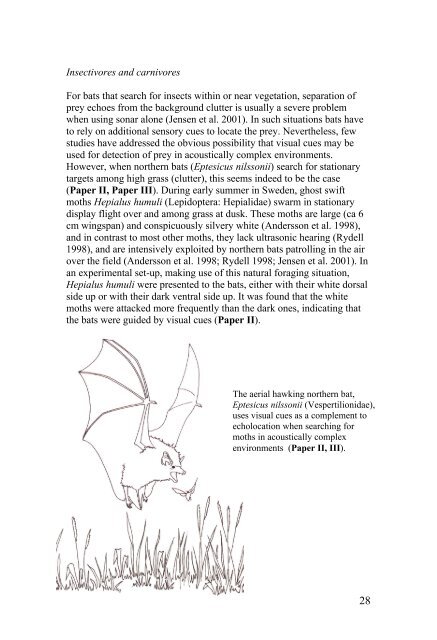Vision in echolocating bats - Fladdermus.net
Vision in echolocating bats - Fladdermus.net
Vision in echolocating bats - Fladdermus.net
You also want an ePaper? Increase the reach of your titles
YUMPU automatically turns print PDFs into web optimized ePapers that Google loves.
Insectivores and carnivores<br />
For <strong>bats</strong> that search for <strong>in</strong>sects with<strong>in</strong> or near vegetation, separation of<br />
prey echoes from the background clutter is usually a severe problem<br />
when us<strong>in</strong>g sonar alone (Jensen et al. 2001). In such situations <strong>bats</strong> have<br />
to rely on additional sensory cues to locate the prey. Nevertheless, few<br />
studies have addressed the obvious possibility that visual cues may be<br />
used for detection of prey <strong>in</strong> acoustically complex environments.<br />
However, when northern <strong>bats</strong> (Eptesicus nilssonii) search for stationary<br />
targets among high grass (clutter), this seems <strong>in</strong>deed to be the case<br />
(Paper II, Paper III). Dur<strong>in</strong>g early summer <strong>in</strong> Sweden, ghost swift<br />
moths Hepialus humuli (Lepidoptera: Hepialidae) swarm <strong>in</strong> stationary<br />
display flight over and among grass at dusk. These moths are large (ca 6<br />
cm w<strong>in</strong>gspan) and conspicuously silvery white (Andersson et al. 1998),<br />
and <strong>in</strong> contrast to most other moths, they lack ultrasonic hear<strong>in</strong>g (Rydell<br />
1998), and are <strong>in</strong>tensively exploited by northern <strong>bats</strong> patroll<strong>in</strong>g <strong>in</strong> the air<br />
over the field (Andersson et al. 1998; Rydell 1998; Jensen et al. 2001). In<br />
an experimental set-up, mak<strong>in</strong>g use of this natural forag<strong>in</strong>g situation,<br />
Hepialus humuli were presented to the <strong>bats</strong>, either with their white dorsal<br />
side up or with their dark ventral side up. It was found that the white<br />
moths were attacked more frequently than the dark ones, <strong>in</strong>dicat<strong>in</strong>g that<br />
the <strong>bats</strong> were guided by visual cues (Paper II).<br />
The aerial hawk<strong>in</strong>g northern bat,<br />
Eptesicus nilssonii (Vespertilionidae),<br />
uses visual cues as a complement to<br />
echolocation when search<strong>in</strong>g for<br />
moths <strong>in</strong> acoustically complex<br />
environments (Paper II, III).<br />
28


